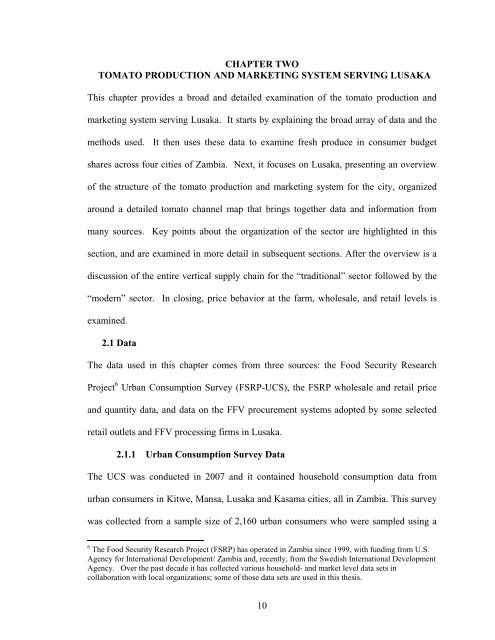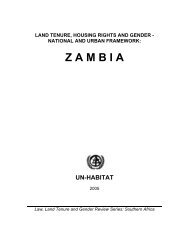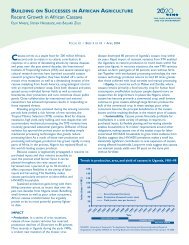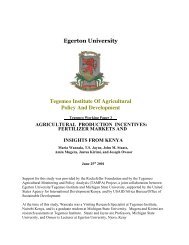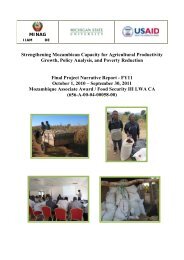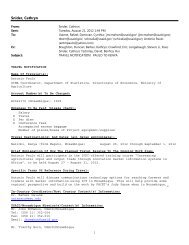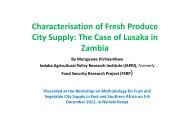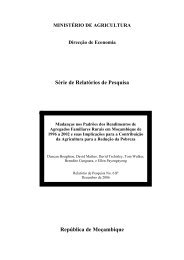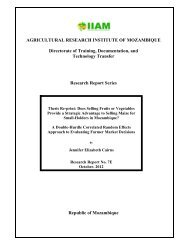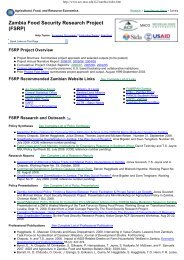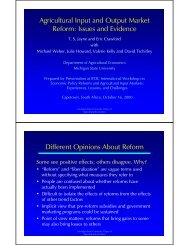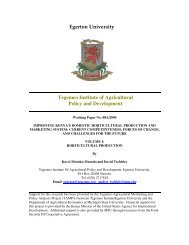i AN ASSESSMENT OF TOMATO PRICE VARIABILITY IN LUSAKA ...
i AN ASSESSMENT OF TOMATO PRICE VARIABILITY IN LUSAKA ...
i AN ASSESSMENT OF TOMATO PRICE VARIABILITY IN LUSAKA ...
You also want an ePaper? Increase the reach of your titles
YUMPU automatically turns print PDFs into web optimized ePapers that Google loves.
CHAPTER TWO<br />
<strong>TOMATO</strong> PRODUCTION <strong>AN</strong>D MARKET<strong>IN</strong>G SYSTEM SERV<strong>IN</strong>G <strong>LUSAKA</strong><br />
This chapter provides a broad and detailed examination of the tomato production and<br />
marketing system serving Lusaka. It starts by explaining the broad array of data and the<br />
methods used. It then uses these data to examine fresh produce in consumer budget<br />
shares across four cities of Zambia. Next, it focuses on Lusaka, presenting an overview<br />
of the structure of the tomato production and marketing system for the city, organized<br />
around a detailed tomato channel map that brings together data and information from<br />
many sources. Key points about the organization of the sector are highlighted in this<br />
section, and are examined in more detail in subsequent sections. After the overview is a<br />
discussion of the entire vertical supply chain for the “traditional” sector followed by the<br />
“modern” sector. In closing, price behavior at the farm, wholesale, and retail levels is<br />
examined.<br />
2.1 Data<br />
The data used in this chapter comes from three sources: the Food Security Research<br />
Project 6 Urban Consumption Survey (FSRP-UCS), the FSRP wholesale and retail price<br />
and quantity data, and data on the FFV procurement systems adopted by some selected<br />
retail outlets and FFV processing firms in Lusaka.<br />
2.1.1 Urban Consumption Survey Data<br />
The UCS was conducted in 2007 and it contained household consumption data from<br />
urban consumers in Kitwe, Mansa, Lusaka and Kasama cities, all in Zambia. This survey<br />
was collected from a sample size of 2,160 urban consumers who were sampled using a<br />
6 The Food Security Research Project (FSRP) has operated in Zambia since 1999, with funding from U.S.<br />
Agency for International Development/ Zambia and, recently, from the Swedish International Development<br />
Agency. Over the past decade it has collected various household- and market level data sets in<br />
collaboration with local organizations; some of those data sets are used in this thesis.<br />
10


